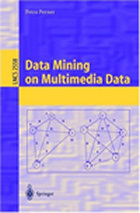Data Mining on Multimedia Data
(Lecture Notes in Computer Science)
Petra Perner
Price: EURO 44,95
ISBN 978-3540003175
Order Now
Despite being a young field of research and development, data mining has proved to be a successful approach to extracting knowledge from huge collections of structured digital data collection as usually stored in databases. Whereas data mining was done in early days primarily on numerical data, nowadays multimedia and Internet applications drive the need to develop data mining methods and techniques that can work on all kinds of data such as documents, images, and signals.
This book introduces the basic concepts of mining multimedia data and demonstrates how to apply these methods in various application fields. It is written for students, ambitioned professionals from industry and medicine, and for scientists who want to contribute R&D work to the field or apply this new technology.
See, what well-known experts in the field said about the book:
Ovidio Salvetti
Ovidio Salvetti
CNR-ISTI, Pisa, Italy
December 2009
I currently read the book Data Mining on Multimedia Data by Petra Perner. This is not an edited book as it might look like when seeing that it has been published within the Lecture Notes in Artificial Intelligence. It is a full text book and has been published in 2002. At that time it was one of the first book on Data Mining on Multimedia Data.
As mentioned in the Conclusion the book gives an overview and does not describe all aspects of data mining. Therefore, it results as quite concise since the arguments are often presented with short comments and details.
More recent analogous works face also topics that have become quite relevant and of interest in many theoretical and application fields.
I refer for instance to arguments like multimedia data exploration and visualization, multi-resolution clustering of time series and their application to images, image retrieval principle in image mining and visual ontology, video event mining via multimodal content analysis and classification or structure-based mining of hierarchical data from multiple sources. And more also video data mining or statistical mining or soft-computing-based mining or relationship of multimedia data mining to other related areas, such as artificial intelligence, or examples where multimedia data mining can solve many real-world problems, such as image annotation, video search, and audio classification.
Nevertheless, I think that the topics discussed in the book are presented in a formally corrected way and that this self-contained book introduces (at that date) some of the most current, state-of-the-art multimedia data mining concepts and theory.
Besides, it introduces also relevant theoretical foundations of multimedia data mining, presenting commonly used methods and techniques, like feature selection or case-based reasoning. It then provides also application examples that showcase the great potential of multimedia data mining technologies.
In conclusion, the book evidenced how the multimedia and data mining research could improve the understanding and drive positively the development of knowledge discovery in multimedia data.
